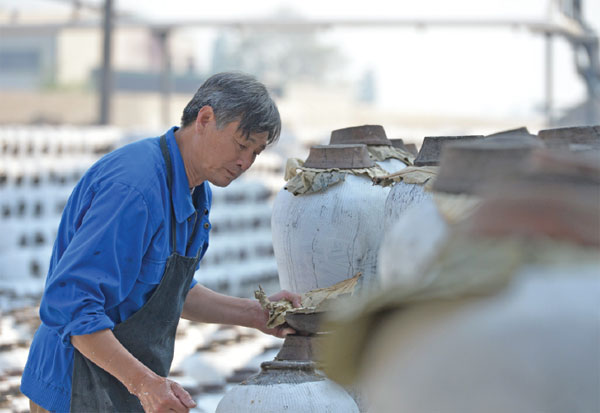Mellow yellow
|
Liquor producer Xie Shouxian checks the fermentation of huangjiu in Shenyonghe Brewery in Shaoxing during its winter brewing. Photos Provided To China Daily |
Traditional huangjiu keeps spirits high in Shaoxing. Xing Yi reports.
Fiery and strong baijiu, or white liquor, is a mainstay for a feast in northern China, where people "bottoms up" with the potent alcohol to show respect to each other. In southern China, however, especially along the south and lower reaches of the Yangtze River, huangjiu (yellow wine) is usually favored by people for its rich and mellow taste.
Fermented from glutinous rice and wheat, huangjiu has a hue of amber, and depending on the degree of fermentation and the aging time, the color varies from a very light gold to a deep chocolate brown. It's usually less than 20 percent alcohol by volume.
With a brewing history of more than 2,500 years, huangjiu is believed to be one of the oldest alcohol drinks in China. The earliest text record traces back to the Spring and Autumn Period (770-476 BC).
Just as Bordeaux is the holy land of wine in France, Shaoxing, an old water town an hour's drive to the southeast of Hangzhou, Zhejiang province, is widely regarded as the home for yellow wine in China. Its local brewing technique was listed as a State-level intangible cultural heritage in 2006.
Shaoxing huangjiu has been given to many foreign leaders as official state gifts. In September 2015, when President Xi Jinping visited the United States, Shaoxing huangjiu was on the menu for the state dinner in White House as a pairing wine for the wild mushroom soup with black truffle.
There are many brands and names for huangjiu, but are largely fall into four types - yuanhong (the driest, with 1 percent sugar or less), jiafan, shanniang and xiangxue (extra-sweet, with 20 percent sugar or more) - with color ranging from light to dark amber.
Yuanhong ("Champion's red" is the basic version from which the others are crafted. For example, when brewing the semi-dry jiafan, which literally translates as "add rice", the makers add more glutinous rice than the amount of rice in yuanhong, while the making of shanniang uses yuanhong to replace part of the water in its brewing process.
Shaoxing huangjiu is aged in earthenware vats, sometimes for decades. The longer it ages, the better the quality, and the aged spirit is usually reserved for special occasions.
Unlike most alcohol in the West that is drunk cold, local people love to drink huangjiu warm, and usually drink it with edamame beans, stinky tofu or salty fish. Huangjiu is also used as a cooking wine in China.
But if you really want to drink huangjiu cooled, add some ice with plum, lemon or ginger into the wine and you have a refreshing summer drink.
Just like sake with sashimi, and red wine with steak, huangjiu and crab is a classic combination: Chinese people believe that crab is a cooling food, and the warmed yellow wine does the necessary countering to keep balance of yin and yang in human body.
In order to appeal to young people's taste, a local producer also invented a huangjiu-flavored ice-cream stick, which appeared in stories this summer. Wrapped in golden foil, the novel ice-cream was an instant hit, with more than 10,000 sticks sold in the first month.
If you travel to Shaoxing, don't forget to visit the museum of huangjiu located in the northwest of the city, where you can watch the whole brewing process in the workshop, go down to the cellar, and taste the different types of huangjiu.
Contact the writer at xingyi@chinadaily.com.cn



















